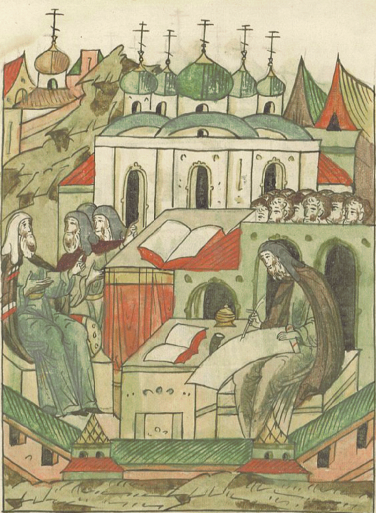Theorization of Russian autocracy
The divine foundation of power in the thought of Iosif Volockij

Iosif Volotsky writes a work against the Judaizing heretics, Illustrated Chronicle of Ivan the Terrible, 1568 – Wikimedia Commons
Iosif Volotsky (1440–1515) was a monk active in the Volokolamsk region, west of Moscow, where he founded a cenobitic monastery inspired by the Studite Rule. This monastic tradition emphasized external discipline over inner spirituality and prioritized collective prayer over individual devotion.
His ideology was marked by an uncompromising stance against heresy, a theme he extensively explored in his principal work, The Enlightener (Prosvetitel’, c. 1502). He viewed heresy as a threat not only to spiritual authority but to the temporal power upon which the state was founded. He argued that heresy should be eradicated not only through prayer but also by the sword of the sovereign, the defensor fidei. He believed that the salvation of the soul could only be ensured through the establishment of an Orthodox state intrinsically tied to the Church, achieving full convergence between secular and religious spheres — what he envisioned as Holy Russia, the Third Rome.
Iosif’s vision thus contributed to strengthening the bond between church and state while promoting the concept of the divine origin of supreme state power, reinforcing autocratic rule. In The Enlightener, he asserted that one must bow to and obey the Tsar, as this was pleasing to God. According to Iosif, Tsars were men favored by God and endowed with divinely ordained power, yet they remained human. They could inflict suffering upon the body but not upon the soul; therefore, they were to be served with the body, but not with the spirit.
The Tsar also had obligations toward both his subjects and God. Iosif maintained that a sovereign must govern according to the principles of the Gospel, fulfill the will of God, and care for the well-being of his people, who, in return, owed him obedience. If a ruler neglected his people and lacked fear of God, he became a servant of Satan, transforming from a shepherd of God’s flock into a wolf. If he was ruled by evil passions, sin, malice, deceit, pride, and fury, he was no longer a sovereign but a tyrant (mucitel’). In such a case, subjects were no longer bound to submit to him, for obedience was not owed to a ruler who led them into dishonesty and corruption.
Giovanni Codevilla, Storia della Russia e dei Paesi limitrofi: Chiesa e Impero, vol. I: Il medioevo russo, secoli X-XVII, Milan, Jaca Book, 2016.
07/12/2025
Salvatore Ciccarello